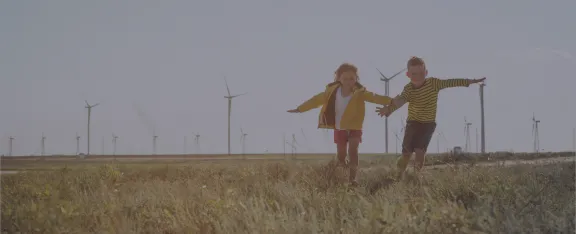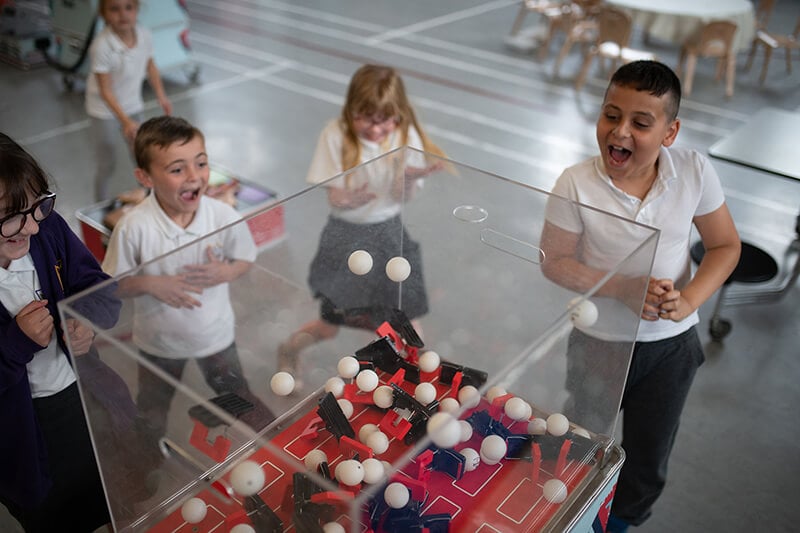ENERGY, TRANSPORT AND TRAVEL
How does the energy we use and the way we travel impact our planet? Investigate the role renewable energy sources, as well as active travel choices, have in our transition to sustainable living.
We hope you have enjoyed the Energy, Transport and Travel theme. If you would like to learn more about the topics, please explore the additional resources below from https://ourfuture.energy
OurFuture.Energy is the place for teachers to find all the energy-themed resources you'll need for your classroom. The website features an ever-growing bank of curriculum-aligned resource materials for schools in England, Wales, Scotland and Northern Ireland. It's also brilliant for 11 to 16-year-olds to use when studying for homework or exams.
On your next visit, come and explore Glasgow Science Centre's Powering the Future exhibition. You can get hands-on with a range of engaging energy-themed exhibits. You can also explore topics like energy supply and use with a focus on affordability, security and environmental sustainability.
Additional Resources
Powering The Future Worksheets
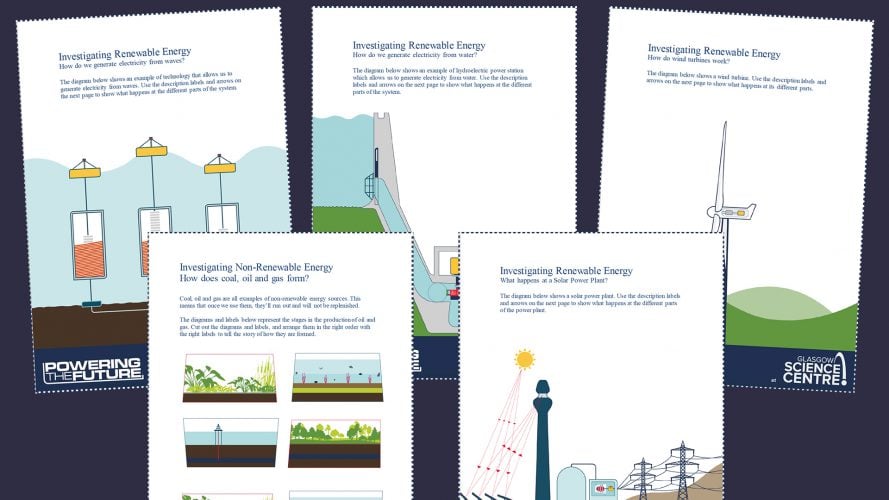
A series of worksheets to download and use in class when learning how various sources of renewable and non-renewable energy can be sourced and used to generate power. These worksheets were shared to support the ‘Powering the Future’ exhibition.
Oil, Coal and Gas Formation – PDF
The Energy Hierarchy
Energy, where it comes from, and how we use it has always been a key topic of conversation when it comes to our current climate crisis. Whilst more Scotland’s electricity than ever before comes from renewables, moving to a fully sustainable energy system is still going to come with significant challenges. If Scotland is going to reach net-zero emissions by 2045, individuals, industries and policy makers will need to work together to reduce the impact of our energy demands on the planet.
One suggestion for how we could transition to sustainable energy is The Energy Hierarchy. The Energy Hierarchy lists the actions policy makers, industry and consumers need to take when it comes to energy sources and use, in order of most sustainable to least.
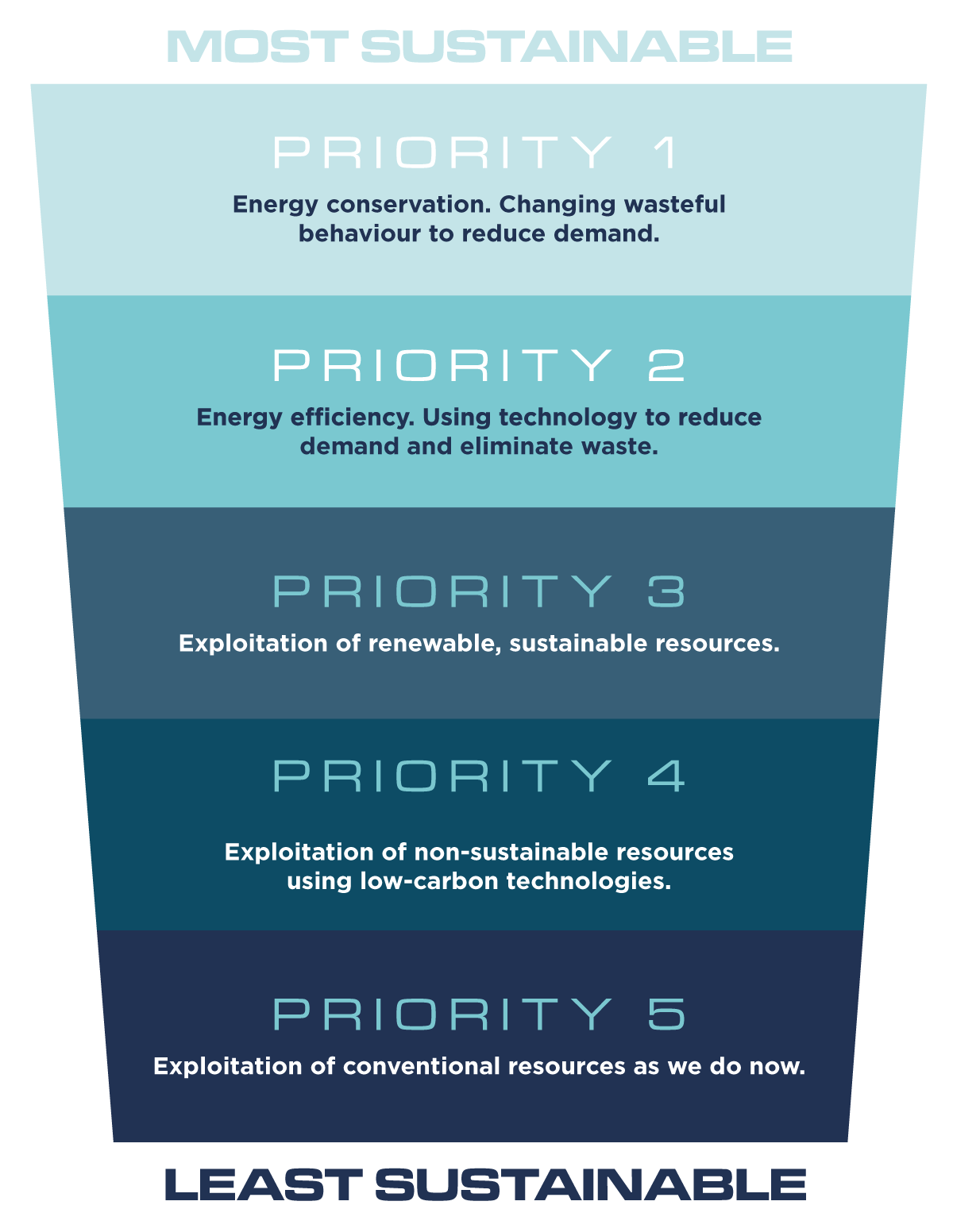
The Energy Hierarchy lists the actions policy makers, industry and consumers need to take when it comes to energy sources and use, in order of most sustainable to least.
PRIORITY 1
Priority 1 looks at changing our own behaviour when it comes to energy, so doing things like lowering your heating at home, turning appliances off completely rather than on standby, making less journeys in the car if not needed, etc.
PRIORITY 2
Priority 2 is similar as it looks at using less energy, but this step focuses more on relying on technology to make changes, rather than just your behaviour.
So making gadgets more energy efficient, or making sure your home is well insulated so you don’t lose as much heat through windows and roofs.
This also extends to larger technology such as power stations; making sure they are efficient in converting energy sources into the useful forms energy that we can use.
PRIORITY 3
Priority 3 looks at increasing our use of low-carbon energy sources, such as wind, solar, hydro and nuclear.
PRIORITY 4
Priority 4 highlights the continued use of fossil fuels as part of our energy mix, with an emphasis on using them in a more sustainable and cleaner way, such as adding Carbon Capture and Storage technology to reduce their impact on the environment and increase efficiency or switching from coal to natural gas as it is the cleanest fossil fuel.
PRIORITY 5
Priority 5 is a business-as-usual approach, using fossil fuels as we do now while they are available.
This Hierarchy can act as a guide for long term change that focuses on changing habits and behaviour as the highest priority. This can apply on an individual level of energy saving habits at home as well as industries implementing energy saving policies. The Energy Hierarchy places importance on sustainability not just in how our energy is generated but also in how we use it as a resource for our daily lives.
If you would like to learn more about energy and our planet, you can access a wide range of educational resources at ourfuture.energy.
Learn about different methods of energy generation and how it works or test out your energy saving knowledge by taking our everyday energy quiz.
Energy Trilemma Resource
We have teamed up with Children’s University Scotland to create simple and fun activities to get you thinking about the energy trilemma and what it means in your everyday life.
They help you understand the basic science behind the energy sector and look at how we can reach a balance of secure, affordable and sustainable energy.
These three issues are known together as the energy trilemma.
Download the Energy Trilemma Resource PDFs
Energy Trilemma Resource – Introduction PDF
Energy Trilemma Resource – Security PDF
Energy Trilemma Resource – Affordability PDF
Energy Trilemma Resource – Sustainability PDF
Energy Trilemma Resource – Answers PDF
Completing the Activities
The activities are suitable for Children’s University passport holders aged 11-14, and include a mix of creative, imaginative and problem solving activities.
Each activity comes with 3 ‘Essential Reading Links’ to the website, which will give you some background knowledge and ideas to help you complete the tasks.
There are also ‘Quiz Links’ you can complete on the website and enter your score in the box provided.
Once you have completed the activities, remember to take your worksheets and Children’s University passports to school to receive your credit.
Hydrogen Hopes
Hydrogen
Hydrogen is an extremely valuable material.
It can be used to separate crude oil so we are left with many more useful products such as diesel, petrol and jet fuel. We can add and take away from it to produce new useful by-products, as well as use it as a cleaner replacement for fossil fuels.
All these different uses make hydrogen a big hope for future low carbon energy needs in many different areas. But first of all…
HOW DO WE GET HYDROGEN?
Hydrogen is the most abundant gas in the universe. However, here on Earth it is only found deep in the earth’s crust or in other elements that we have to separate it from.
Electrolysis – Electricity can separate water into hydrogen and oxygen, in effect turning electrical energy into chemical energy. This is carried out using electrolysis. To keep hydrogen production as clean as possible, electricity produced by renewable or nuclear energy is preferable.
Steam methane reforming – This is the most common way we currently produce hydrogen. Methane (the main element in natural gas) reacts with oxygen or water, to produce hydrogen and carbon dioxide. The carbon can then be used as a building material or in other useful ways. If we can add Carbon Capture and Storage to this process, we can cut down the harmful emissions produced by the carbon dioxide.
Biomass –Biomass materials can go through a process that produces hydrogen, which again when carbon capture is used, can result in very few emissions.
Now we know how to get it, what can we do with it?
HEATING
Heating makes up to 85% of the energy we use at home, on keeping both ourselves, our food and our water as hot or cold as we need (or like!).
Gas is the most common energy source, used for heating spaces in 84% of homes, and for cooking hobs in 61% of homes.
While natural gas is the cleanest of the fossil fuels, it still produces carbon dioxide when burned (combusted). So what if we could swap all that natural gas for hydrogen? Hydrogen does not give off any carbon dioxide when combusted, meaning it is a cleaner alternative to natural gas.
There is a major project happening in Leeds called H21 Leeds City Gate, which aims to see if the city’s current natural gas that it uses for heating can be switched with hydrogen. However, natural gas would still be needed in order to get the hydrogen to begin with (see steam methane reforming above).
This involves quite a lot of work changing the original metal pipes that transport the gas around the city, to plastic pipes that can handle hydrogen (as metal pipes can’t), as well as making sure the appliances (such as ovens and boilers) are able to work with hydrogen rather than gas.
However, the changes that need to be made to the pipes is small compared to the time, money and effort saved by using the original motorway-like pipe network that the city already has underground. This work is already being carried out across the UK, separate from the Leeds project.
If this project works in Leeds, your city could be next!
TRANSPORT
Transport is the biggest user of energy in the UK, so any changes we can make to produce less carbon dioxide in this area would make a huge difference to the climate.
Oil is the main source of energy used for transport, taken from the ground in its natural state before then being broken up into more useful parts (fractions) such as diesel and petrol. However, electric transport is beginning to grow in popularity, as are alternative fuels like biofuel and hydrogen.
Hydrogen fuel cells produce electricity by reacting hydrogen (the fuel) with oxygen. This electricity then powers the motor to move the car (or bus, or lorry, or train!)
Again, hydrogen does not produce any carbon dioxide when combusted, while diesel and petrol do. In fact, the only waste product of using hydrogen fuel cells in transport is water!
If we can change our transport from fossils fuels to hydrogen fuel, then we could cut a massive amount of carbon dioxide from the atmosphere. This would have a positive effect on air pollution levels too, which can seriously affect health.
Find out more about air pollution here.
STORAGE
Hydrogen is one of several solutions being researched as an alternative method to batteries for storing energy when it’s not needed, so that we’re not losing any valuable energy that we could use at a later time.
Electricity can separate water into hydrogen and oxygen, in effect turning electrical energy into chemical energy. This is carried out using electrolysis.
The hydrogen produced is one way of storing excess electricity, being stored underground in empty oil and gas caverns or salt domes.
Hydrogen can be mixed with carbon dioxide to produce methane and water. The methane is stored and used to produce electricity, while the water can be recycled for use elsewhere. Methane can be passed through gas turbines, used in compressed gas vehicles or for heating.
Future Grid
A continent-wide super grid could help to balance the electricity network and allow a huge expansion of generation from renewable sources.
The idea behind the electricity ‘future grid’ is that countries can work together to make their energy supply more secure, cleaner and more affordable for consumers. In other words, improving each of the three issues in the energy trilemma (resource above)
Some solutions to do this include:
- Taking advantage of renewable resources from other countries, such as solar energy from sunnier countries in the South, in exchange for wind and hydro energy in the North, to make sure there is clean energy available for everyone at all times.
- As more electricity is generated by consumers at their end, the extra electricity they generate can be given back to the bigger grid so someone else can use it or it can be stored until needed.
- The move from a few big power stations that decide how much to generate and how much people will need, to lots of little ones all over the country that can generate and use when needed and give back what they don’t use, and be paid for it!
However, there will be challenges involved:
- Power lines travelling long distances are likely to have an impact on the environment and the landscape, so there may be some resistance over having these lines above ground. There has been such a discussion in Germany, with plans to take wind from the north of the country to the south changed, so now the power will be transported underground rather than overground.
- This solves the argument of affecting the landscape, but adds on much more time and money, which are also factors that need to be added in.
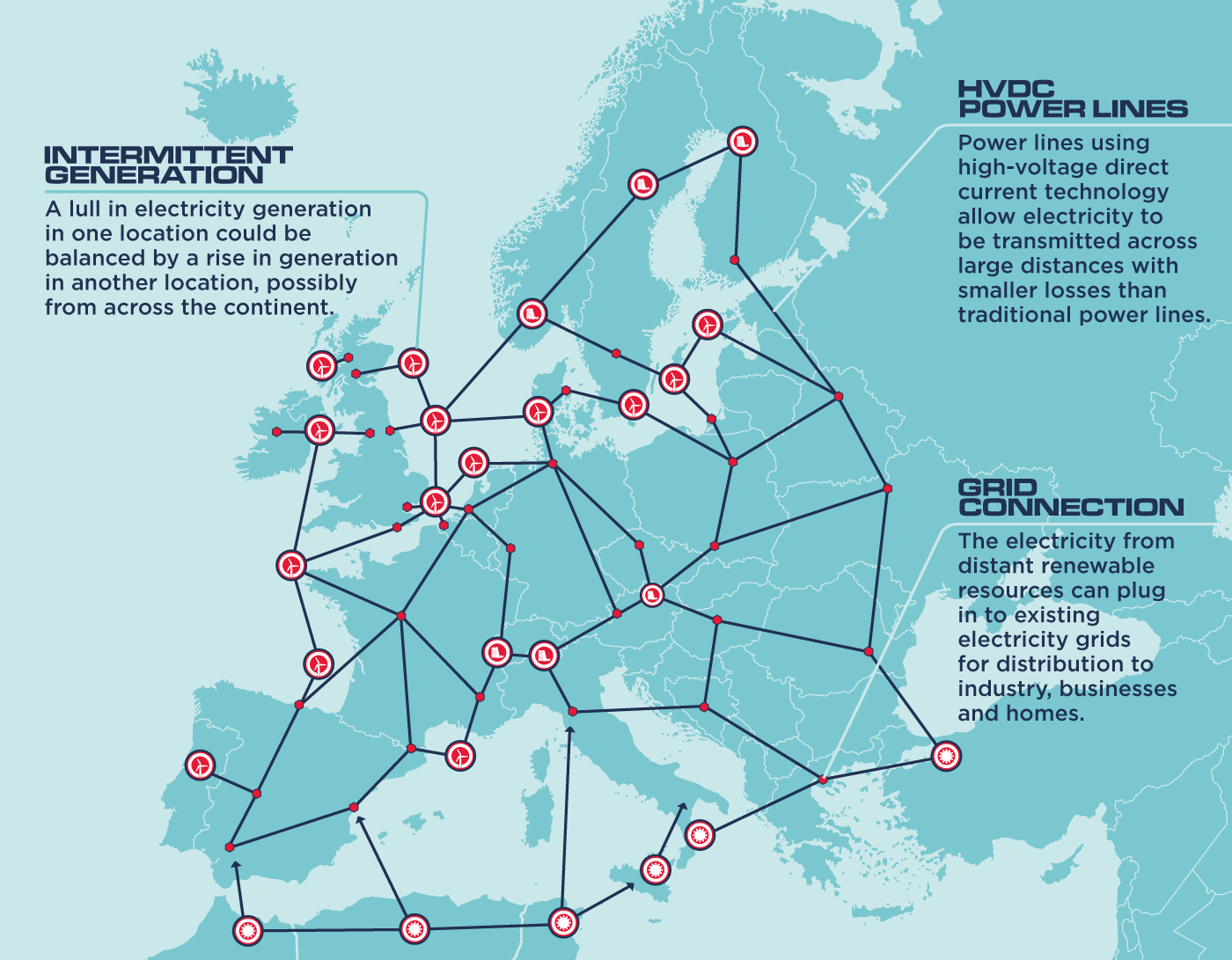
Energy and the Environment
It’s well known that when we use fuels such as coal and oil, that these energy sources are having a negative effect on our atmosphere and our air quality.
However, most energy sources affect our environment in some way, and these need to be identified so we can make sure we are harnessing them sustainably.
WILDLIFE
Problem
Building power stations, wind and solar farms and other methods of harnessing energy cannot be complete without changing a landscape in some way, and often this includes changing the habitats of some types of wildlife.
It has been suggested that wind turbines can affect birds and bats, whilst hydroelectric dams and tidal machines are damaging to sea life.
It can also work the other way, with wildlife affecting the power stations. Jellyfish can cause problems when large amounts of them get caught up in the cooling water power station use to cool their turbines.
Solution
Despite worries that wind turbines could affect to birds, reports show that most wind turbines actually move too slowly to cause any harm, and reports of their damage are very few.
In fact, some reports show that offshore wind turbines can actually prove to be good at providing artificial reefs for sea life which increase fish populations, rather that decrease them.
In terms of hydroelectric dams, which often result in changing the direction of a river’s flow, fish ladders have long been a solution to help fish, in particular salmon, travel upstream more easily.
To help keep jellyfish out of cooling water paths, there are studies being carried out by companies like EDF and university researchers to find out where large groups of jellyfish are, and moving them safely out of the path of the power stations before they get stuck.
These types of solution will need to be discussed if the new Swansea Bay Tidal Array in Wales gets the go ahead from officials.
WATER SOURCES
Problem
Power stations generate a large amount of heat energydue to the combustion of fuels such as oil, gas and uranium for nuclear power.
Because of this, a lot of water is needed to cool downcertain areas of the stations, and being situated next to rivers and lakes provides a constant source of water.
However, this also means there can be environmental issues when the water is returned to where it came from, as it is warmer than before, and has new minerals, salts and sometimes high levels of sulphur which are not good for sea life or people downstream using the water for drinking, food preparation or other reasons
This is also true of water used in geothermal and hydroelectric power plants.
Offshore oil and gas platforms can pose a risk to sea life if an oil spill occurs. Researchers have also noticed birds can be affected by oil spills due to habitats near sand or feeding on fish that have came into contact with oil spills.
Gas extraction, specifically hydraulic fracturing (fracking), raises questions amongst some environmentalists as to its effect on aquifers (like underground rivers) which we use to get water in our homes and buildings.
The second is the concern that potentially dangerous chemicals may escape and contaminate groundwater. However, in the UK the Environment Agency approves the chemicals being used; hazardous or dangerous chemicals are not allowed.
The industry suggests pollution incidents are the results of bad practice, rather than an inherently risky technique and that the risk can be minimized by sticking to very high health and safety standards.
Solution
To make sure hydroelectric dams cause the least amount of change to a river’s natural habitat for fish, plants and other inhabitants, when water is released to allow the dam to stay at the correct level, it is at specific times of the year, and only a certain amount is released.
This allows fish to match up their reproduction cycles to times when the river is best suited for offspring to survive and not be affected by loss of food or shelter that the release of water would cause.
Despite hearing of major oil spills in the news, such as that in the Gulf of Mexico in 2010, they are actually quite rare. Damage assessments are carried out so that the right people are aware of the impact they can have on surrounding environment and researchers are always looking at ways to limit the damage caused.
For example, there were recent studies into how magnets could be used to clean up spills quickly before any major damage can be done.
In the UK, hydraulic fracturing is thoroughly regulated by different organisations and government bodies to make sure it is carried out safely, so that our water sources are not affected.
LAND
Problem
Much like its effect on wildlife, changing landscapes for energy use brings changes to the land that can affect its other possible uses.
Biomass is a renewable source of energy, as we can continue growing it so it can be used as a fuel for electricity generation, transport and heating. However, decisions need to be made over a piece of land being used for growing biomass instead of for food or grazing for animals.
The chemicals used on land for growing biomass can affect the land’s future use, as any crops grown on it may not be fit to be eaten by humans or animals.
Geothermal sources can sometimes result in land sinking where water has been removed. Geothermal areas also tend to be around earthquake or volcanicareas so disrupting these pieces of land can cause issues.
Areas marked for use for hydroelectric power stations have a major effect due to flooding, wildlife and in some cases displacing communities who can no longer use the water the area provided, like in the case of the Three Gorges Dam in China.
Solution
Wind turbines and solar panels can be placed on land that cannot be used for agriculture, and wind turbines still allow cows and other field animals to graze and move around openly.
Solar panels can also be installed on roofs of homes, buildings, etc. to cut down on the amount of land they might take up usually or again on unused agricultural sites.
In the case of sunken land, wastewater can be reinjected to make sure the land does not sink.
Environmental reports are carried out to limit any possible problems with earthquake prone areas where geothermal energy can be reached.
Quiz - Getting Around
Transport uses a large amount of energy, so knowing a little more about this subject to impress friends and family will make you look pretty clued up!
Test your current knowledge and learn some interesting facts along the way with the Getting Around – Transport Quiz below.
#GSCAtHome: Powering the Future playlist
Energy underpins our modern lives but there are difficult choices to be made about how we will supply and use energy in the future. Is our energy affordable, secure and environmentally sustainable? Explore this playlist and together we will:
⚡Join Caitlin, who is here with an introduction to what energy is and how it works, some different types of energy, and some energy phrases that you might have heard of.
?Learn with Amy how we can generate electricity from different types of energy. Then, explore the basics of transferring chemical energy into movement energy as you design your own simple motor using a battery, copper wire, and a neodymium magnet
?️Join Sabah and harness the power of the wind! Learn about renewable energy by making your own simple model wind turbine.
?In this #PoweringTheFutureWeek video from #GSCAtHome, you can make a model water wheel as you investigate how to change the movement energy in flowing water to something more useful.
?️Your mission, should you choose to accept it, is to design your own transport of the future. What will it look like? How will it be powered?
Learning Lab - Energy
Welcome to GSC Learning Lab: Our World, Our Impact.
In school, P5-7 pupils are learning about how climate change is affecting our world by taking part in practical activities, talking to Climate Science experts, and being inspired by spectacular demonstrations.
Pupils are investigating the themes of: Climate & Weather; Energy; Biodiversity and Food and we are delighted that this valuable learning can continue at home through a suite of activities designed to promote family learning.
In this video, Amy will focus on energy, what it is, and how we use it.

